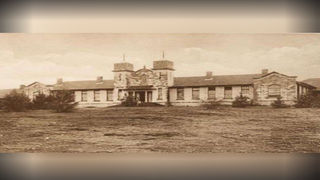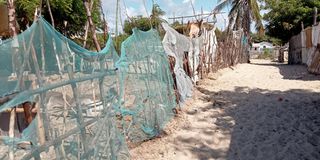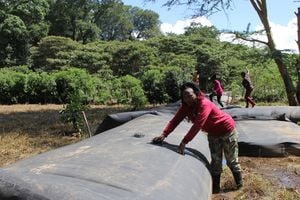
The European Nairobi Hospital.
| FileNews
Premium
Lessons from Grogan, State House Girls, Kirima land
Watching Alice Wahome, the Cabinet Secretary for Lands, abandon the squatters who had built on Gerishon Kirima’s land in Nairobi reminded me of the story of Ewart Grogan and the European Nairobi Hospital, now the administration block of State House Girls School in Nairobi.
There are history lessons we can learn if we care to look. We can learn that an illegality doesn’t have to end with a demolition. If it had, House Girls High School would not have started.
Grogan was one of the first white settlers in Nairobi, having acquired more than 113 acres in Chiromo, the land on which State House Girls school stands, and parts of the Nairobi River.
Having built his residential house in Chiromo after hiring the Indian fundis who had decided to stay after completing the Uganda railway, Grogan wanted to develop his Nairobi property. But he was surprised one afternoon when approaching Chiromo from Hospital Hill to realise there was construction at his farm.
That could be the same feeling Kirima had as he watched squatters invade his Njiru Farm and start building. Kirima was also one of the first African real estate entrepreneurs in post-independent Nairobi, having bought his land from an exiting settler.
After Grogan saw the construction on his farm, he would later narrate, he enquired from the colonial government surveyor what was happening.
“We are building a hospital,” the surveyor informed him, and Grogan, who was said to be one of the jocund characters in the colony, quipped: “Oh. How interesting, Nairobi does need a hospital.”
He then left for Chiromo. It is not clear what was going on in his mind, but he constantly clashed with the government and had a low opinion of its officers or what he called: “Those human silverfish feeding on their files.”
To digress, Grogan once had a row with government officials for being stopped from making bricks from the clay at the current junction of Globe Cinema and Kijabe Street.
He was asked to take a prospecting licence since clay was considered a mineral. Grogan took the permit and then started digging holes along Government Road and staking a claim on the clay. He vowed to dig many other holes in all towns until the ridiculous law declaring mud to be a mineral was changed. The mining commissioner, Charles Hobley, was made to remove clay from the list of minerals.
It is still one of the legacies of Grogan’s fight with the government.
Back to the hospital project, according to Grogan’s biographer Ledda Farrant, “weeks passed and indeed the projected European Nairobi Hospital was taking shape.”
It was by then clear that part of it was on Grogan’s land. Interestingly, Grogan did not intervene and watched the hospital take shape. All he did was confirm that this was to be the European Nairobi Hospital.
As construction was aproaching completion, Grogan visited the project and met the engineer: “How very nice of the government to build me a hospital,” he said.
Farrant tells us that the engineer “was not amused and informed Grogan that he was mistaken. The hospital was a government project on government land.”
Grogan looked at the government official.
“Better have your surveyor work out his figures again,” Grogan said.
“You’ll find that part of the land you are building on is actually my land.”
Interestingly, the government, like the Kirima squatters, continued constructing the European Nairobi Hospital.
Later, government officials started getting furious after realising that Grogan was right and that most of the European Nairobi Hospital sat on Groganville – the name he had given to his land, which included parts of Westlands.

Members of Sirikwa Squatters Group demonstrate on the 25,000 acres farm behind Eldoret International Airport after police allegedly demolished structures they were building on June 10, 2022.
They then started blaming Grogan for the mess they had found themselves in.
“If you knew from the beginning that we were building on your land, why did you wait until we started building before pointing out the mistake? There is nothing we can do about it now,” they told Grogan.
“Yes, there is,” he told them. “Just take down that end of it.”
With the law on Grogan’s side, the government decided to negotiate and gave him an offer. And that is how the modern-day administration block of State House Girls School became European Hospital – before a new European Hospital was built later on in the present-day Nairobi Hospital in 1950s.
It is the same position that the people who built on Kirima’s land are finding themselves in. They may have to pull down their structures or negotiate with the modern-day “Grogan.”
Having missed a chance to own a hospital on his land, Grogan would, later, build another hospital – but this time in memory of his wife Gertrude, who had died of a heart attack in July 1943 and was buried at Nairobi Forest Road Cemetery.
In her honour, Grogan had considered turning Gertude’s 17-acre home in Muthaiga into a home for “war orphans”.
A Nairobi doctor, Gerald Neville, who was fundraising to build a children’s hospital, heard of Grogan’s project and went to see him. When Neville expressed interest in the orphan’s project, Grogan cut him short: “Are you an orphan?”
That is how he convinced Grogan that a children’s hospital was better.
But Neville wanted the hospital to be on “the other side of town where other hospitals were.”
“Grogan fixed me with his steely blue eyes,” Neville would later say. “And he said: ‘young man, you are given a gift and you accept it gratefully’.”

Structures belonging to squatters settling on government land at Hidabo area in Lamu County.
That is how Gertrude Garden’s Children Hospital in Muthaiga, Nairobi, was born to accommodate 20 children initially.
It is said that after Kenya gained independence and the colonial empire and its symbols started collapsing, the staff at Gertrude would cover the African children up, fearing Grogan would object their presence.
According to his biographer, “Grogan discovered the trick and every time he went to the hospital, he made straight for the African children’s beds and played with them, as he did with the others”.
The transition from a settler colony appears to have been slow-motioned.
Before he died, he told Edward Rodwell, one of Kenya’s longest-running columnists: “The Lord is very good to me; he had made me almost blind and very deaf.”
He had taken room at Muthaiga Club where he told those who cared to listen that he was “waiting to die”.
Then Grogan, much to the chagrin of his friends, disappeared with Mrs Towers. He was a great friend to Humprey Slade, the Speaker of National Assembly: “We knew nothing until they had left. Grogan’s friends were upset when he vanished. We were sad because he wouldn’t have liked to be anywhere else.”
The end of empire was also ending in untimely exits. The more significant lesson from Grogan and the State House Girls is that demolition of structures can be evaded by negotiations.
But that does not mean squatters invade people’s land and negotiate from within. Nay. But the owners have a responsibility not to watch like Grogan and Kirima and make a move after buildings have been completed.
[email protected] @johnkamau1





